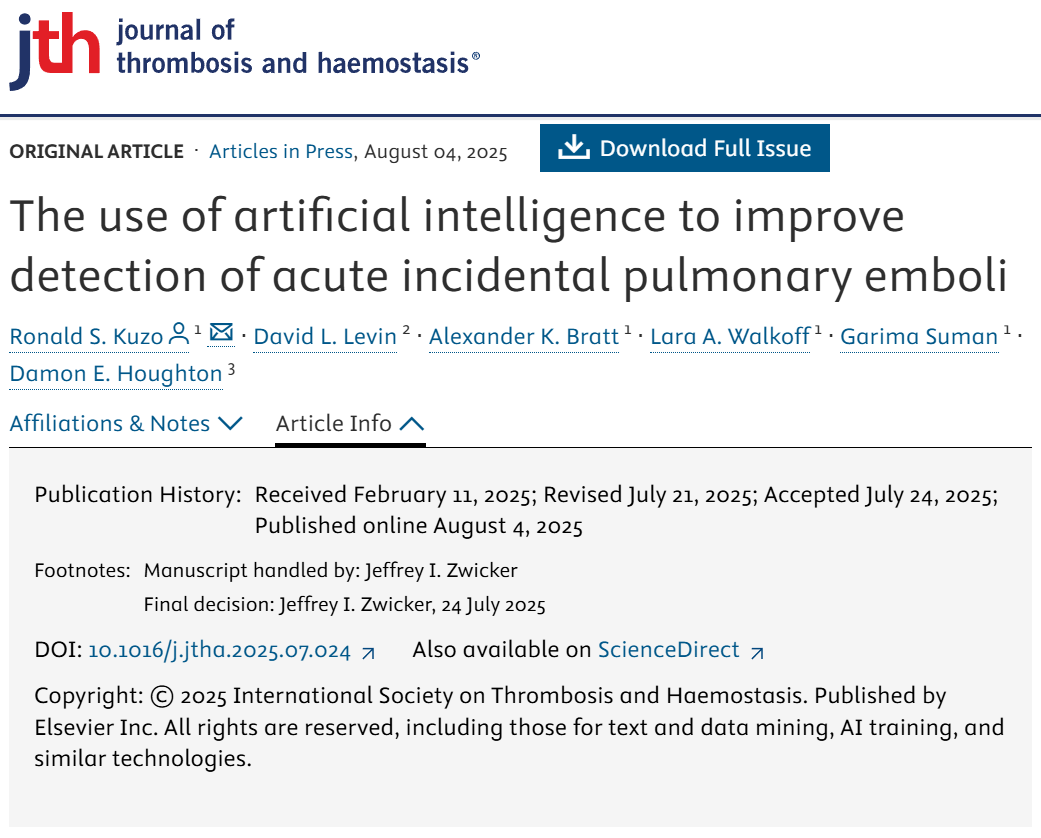
JTH/LinkedIn
Oct 29, 2025, 07:31
The Use of Artificial Intelligence to Improve Detection of Acute Incidental Pulmonary Emboli – JTH
Journal of Thrombosis and Haemostasis (JTH) shared a post on LinkedIn:
“The use of artificial intelligence to improve detection of acute incidental pulmonary emboli
By Ronald Kuzo, David Levin, Alex Bratt, Lara Walkoff, Garima Suman, and Damon Houghton
- Context: Incidental pulmonary emboli (IPE) are often overlooked in imaging performed for other reasons. AI-based detection tools aim to enhance accuracy.
- Study: In 14 453 CT scans from 9 171 patients, a commercial AI algorithm was retrospectively compared with radiologist interpretations.
- Findings: AI identified 36 missed IPEs but also generated 94 false positives and missed 30 radiologist-detected cases. Combined AI + human review yielded the highest overall detection, reinforcing that AI augments rather than replaces radiologists.”
Title: The use of artificial intelligence to improve detection of acute incidental pulmonary emboli
Authors: Ronald S. Kuzo, David L. Levin, Alexander K. Bratt, Lara A. Walkoff, Garima Suman, Damon E. Houghton

Stay informed with Hemostasis Today.
-
Dec 19, 2025, 13:30PPTA Europe’s Holiday Message: Wishing Health, Rest, and Renewal for 2026
-
Dec 19, 2025, 13:22If You Were Reading a “Bible for Blood Donation Volunteers,” What’s the ONE Thing That Must Be in It?
-
Dec 19, 2025, 12:52Julia Owens: Stroke Remains One of the World’s Leading Causes of Death and Disability
-
Dec 19, 2025, 12:03Pradeep Natarajan: Our New Genetic Study of Aortic Stenosis in ~3M
-
Dec 19, 2025, 11:47ESO Blog: Anna Gardin on Stroke Risk in the Era of Climate Extremes
-
Dec 19, 2025, 10:51Sarah Elkourashy Presents Insights on Caplacizumab for TTP at ASH25
-
Dec 19, 2025, 10:08Camilla Lombardi Shares an EHC Nutrition Guide for People with Bleeding Disorders
-
Dec 19, 2025, 09:56Danny Hsu Shares The ”I-WISh” Study by Nichola Cooper on ITP
-
Dec 19, 2025, 09:39Paul Bolaji: A Landmark Achievement -The Historic 1st Nigerian Stroke Leaders’ Summit 2025
